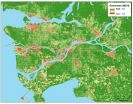(Press-News.org) WASHINGTON, D.C. – In one year, India's ozone pollution damaged millions of tons of the country's major crops, causing losses of more than a billion dollars and destroying enough food to feed tens of millions of people living below the poverty line.
These are findings /of a new study that looked at the agricultural effects in 2005 of high concentrations of ground-level ozone, a plant-damaging pollutant formed by emissions from vehicles, cooking stoves and other sources. Able to acquire accurate crop production data for 2005, the study's authors chose it as a year representative of the effects of ozone damage over the first decade of the 21st century.
Rising emissions are causing severe ozone pollution in some of India's most populated regions. Pollution in Delhi, the nation's capital, has reached levels comparable to Beijing, one of the most polluted cities in the world, according to India's Air Monitoring Center.
The main component of smog, ozone at ground level can cause leaf damage that stifles plant growth, injuring and killing vegetation. There are currently no air quality standards in India designed to protect agriculture from the effects of ground-level ozone pollution, according to the new study. Ground-level ozone is formed when nitrogen oxides, carbon monoxide and volatile organic compounds react with sunlight after the chemicals' release from vehicles, industry, or burning of wood or other plant or animal matter.
According to the new study published Aug.14 in Geophysical Research Letters, a journal of the American Geophysical Union, surface ozone pollution damaged 6 million metric tons (6.7 million U.S. tons) of India's wheat, rice, soybean and cotton crops in 2005.
India could feed 94 million people with the lost wheat and rice crops, about a third of the country's poor, according to Sachin Ghude, an atmospheric scientist at the Indian Institute of Tropical Meteorology (IITM) in Pune, India and lead author of the new study. There are about 270 million Indians that live in poverty, according to the study.
Wheat – one of the country's major food sources – saw the largest loss by weight of the four crops studied in the new paper, with ozone pollution damaging 3.5 million metric tons (3.8 million U.S. tons) of the crop in 2005. Another major food source, rice, saw losses of 2.1 million metric tons (2.3 million U.S. tons), according to the new study.
Cotton – one of India's major commercial crops -- lost more than 5 percent of its 3.3 million metric ton (3.6 million U.S. tons) annual output in 2005, costing the country $70 million, according to the new research.
Policy implications
Ghude said the new paper, which is the first to quantify how much damage India's ozone pollution has caused the country's major crops on a national level, could help policymakers craft new ozone pollution standards.
It could also help India, a country with a high rate of poverty, as the country implements a new law that subsidizes grain for two-thirds of the country's residents, he said. The new food security bill requires the country to provide 61.2 million metric tons (67.5 million U.S. tons) of cereal grains – that include wheat and rice – to India's poor each year at a subsidized rate. The new study found that the 5.6 million metric tons (6.2 million U.S. tons) of wheat and rice lost to ozone pollution was equal to 9.2 percent of the new law's subsidized cereal requirement.
"The (amount of lost wheat and rice) are what surprised me," said Veerabhadran Ramanathan, a professor of climate and atmospheric sciences at Scripps Institution of Oceanography, at the University of California San Diego and a co-author of the new study.
Under the new law, residents who qualify to receive cereal at the subsidized rate can purchase 60 kilograms (132 pounds) of grain per year. Based on these numbers, the 5.6 million metric tons (6.2 million U.S. tons) of wheat and rice lost could therefore feed 94 million people in India, according to the study.
Calculating ozone damage
The researchers calculated the amount of total crop damage from ozone pollution by comparing emissions estimates from 2005 with data about how much ozone each of the four crops could withstand. Plants start to exhibit damage when they are exposed to ozone levels that reach 40 parts per billion or above, according to previous research.
A computer model used by researchers calculated ozone levels during crop growing seasons that were more than 40 to 50 parts per billion over most of the country. The team ran the model with different emissions estimates to come up with an average amount of each crop that was lost due to ozone pollution.
India's economic loss from ozone's harm to crops amounted to $1.29 billion in in 2005, the study found. Declines in rice and wheat crops made up the majority of the loss, accounting for a combined $1.16 billion in losses, according to the new research.
Despite air quality standards passed in the 1980s to curb industrial and vehicle emissions, cities in India are some of the most polluted in the world, according to the World Health Organization. The number of vehicles on the road in India has nearly tripled in the past decade, with 130 million vehicles on the road in 2013 compared to 50 million in 2003, according to the International Council on Clean Transportation.
Long-term measurements of surface ozone over India – measured on the ground or by aircraft -- are not available, making it difficult to get a clear picture of how ozone levels in the country have changed, Ghude said. But satellite-based studies show ozone has increased over the country in the last two decades, Ghude said. Warmer temperatures that are expected with climate change could also increase ground-level ozone, according to previous research.
Ramanathan said that unlike most studies, which look at the effect emissions will have on agriculture decades in the future, the new study examined how ozone emissions are already affecting crops in India. He said the new study could help spur interest in the issue and help policymakers enact new air quality standards or mandate use of new technology to cut emissions.
INFORMATION:
The American Geophysical Union is dedicated to advancing the Earth and space sciences for the benefit of humanity through its scholarly publications, conferences, and outreach programs. AGU is a not-for-profit, professional, scientific organization representing more than 62,000 members in 144 countries. Join our conversation on Facebook, Twitter, YouTube, and other social media channels.
Notes for Journalists
A PDF copy of this article can be downloaded at no cost by clicking on this link: http://onlinelibrary.wiley.com/doi/10.1002/2014GL060930/abstract.
Or, you may order a copy of the final paper by emailing your request to Nanci Bompey at nbompey@agu.org. Please provide your name, the name of your publication, and your phone number.
Neither the paper nor this press release is under embargo.
Title: "Reductions in India's crop yield due to ozone"
Authors:
Sachin d. Ghude: Indian Institute of Tropical Meteorology, Pune, India;
Chinmay Jena: Indian Institute of Tropical Meteorology, Pune, India;
D.M. Chate: Indian Institute of Tropical Meteorology, Pune, India;
G. Beig: Indian Institute of Tropical Meteorology, Pune, India;
G. G. Pfister: Atmospheric Chemistry Division, National Center for Atmospheric Research, Boulder, Colorado, USA;
Rajesh Kumar: Atmospheric Chemistry Division, National Center for Atmospheric Research, Boulder, Colorado, USA;
V. Ramanathan: Scripps Institution of Oceanography, University of California, San Diego, La Jolla, California, USA
Contact information for the authors:
Sashin D. Ghude: +91 (20) 2590-4494, sachinghude@tropmet.res.in
V. Ramantathan: +1 (858) 534-0219, vramanathan@ucsd.edu
AGU Contact:
Alexandra Branscombe
+1(202) 777-7516
abranscombe@agu.org
Nanci Bompey
+1 (202) 777-7524
nbompey@agu.org
Scripps Institution of Oceanography Contact:
Robert Monroe
+1 (858) 822-4487
rmonroe@ucsd.edu
AGU: Ozone pollution in India kills enough crops to feed 94 million in poverty
2014-09-04
ELSE PRESS RELEASES FROM THIS DATE:
Greener neighborhoods lead to better birth outcomes, new research shows
2014-09-04
CORVALLIS, Ore. – Mothers who live in neighborhoods with plenty of grass, trees or other green vegetation are more likely to deliver at full term and their babies are born at higher weights, compared to mothers who live in urban areas that aren't as green, a new study shows.
The findings held up even when results were adjusted for factors such as neighborhood income, exposure to air pollution, noise, and neighborhood walkability, according to researchers at Oregon State University and the University of British Columbia.
"This was a surprise," said Perry Hystad, an environmental ...
Scientists prove ground and tree salamanders have same diets
2014-09-04
Salamanders spend the vast majority of their lives below ground and surface only for short periods of time and usually only on wet nights. When they do emerge, salamanders can be spotted not only on forest floors but also up in trees and on other vegetation, often climbing as high as 8 feet. Given their infrequent appearances aboveground, it has never been clear to biologists why salamanders take time to climb vegetation. Researchers at the University of Missouri recently conducted a study testing a long-standing hypothesis that salamanders might climb vegetation for food. ...
Public trust has dwindled with rise in income inequality
2014-09-04
Trust in others and confidence in societal institutions are at their lowest point in over three decades, analyses of national survey data reveal. The findings are forthcoming in Psychological Science, a journal of the Association for Psychological Science.
"Compared to Americans in the 1970s-2000s, Americans in the last few years are less likely to say they can trust others, and are less likely to believe that institutions such as government, the press, religious organizations, schools, and large corporations are 'doing a good job,'" explains psychological scientist and ...
Researchers turn to plants to help treat hemophilia
2014-09-04
GAINESVILLE, Fla. — Accidents as minor as a slip of the knife while chopping onions can turn dangerous for patients with hemophilia, who lack the necessary proteins in their blood to stem the flow from a wound.
People with severe hemophilia typically receive regular injections of these proteins, called clotting factors, as a treatment for the disease. But up to 30 percent of people with the most common form, hemophilia A, develop antibodies that attack these lifesaving proteins, making it difficult to prevent or treat excessive bleeding.
Now, researchers from University ...
T. rex times 7: New dinosaur species is discovered in Argentina
2014-09-04
Scientists have discovered and described a new supermassive dinosaur species with the most complete skeleton ever found of its type. At 85 feet long and weighing about 65 tons in life, Dreadnoughtus schrani is the largest land animal for which a body mass can be accurately calculated.
Its skeleton is exceptionally complete, with over 70 percent of the bones, excluding the head, represented. Because all previously discovered super-massive dinosaurs are known only from relatively fragmentary remains, Dreadnoughtus offers an unprecedented window into the anatomy and biomechanics ...
INFORMS study: Customer experience matters more when economy is doing better, not worse
2014-09-04
Customer experience matters more when the economy is doing well than when it is doing poorly, according to a new study in the Articles in Advance section of Marketing Science, a journal of the Institute for Operations Research and the Management Sciences (INFORMS).
The study, entitled "Assessing the Influence of Economic and Customer Experience Factors on Service Purchase Behaviors" is by V Kumar, the Regents' Professor, Nita Umashankar, an assistant professor, and PhD candidates Hannah Kim and Yashoda Bhagwat, all at Robinson College of Business at Georgia State University. ...
The Lancet: International health systems fund could have averted Ebola outbreak
2014-09-04
The Ebola crisis in west Africa could have been averted if governments and health agencies had acted on the recommendations of a 2011 World Health Organisation (WHO) Commission on global health emergencies, according to a new Comment, published in The Lancet.
The Comment, written by Professor Lawrence Gostin, Faculty Director of the O'Neill Institute for National & Global Health Law at Georgetown University, USA, calls for renewed international commitment to a health systems contingency fund to prevent another infectious disease crisis, together with long-term funding ...
2014 Breast Cancer Symposium highlights research advances in prevention, screening, therapy
2014-09-04
ALEXANDRIA, Va. – Five studies from the 2014 Breast Cancer Symposium were highlighted today in an embargoed presscast for reporters. Presentations focused on new studies exploring preventive mastectomy, compliance with recommended screening mammography, and risk of recurrence after pre-surgery therapy for breast cancer. The Symposium will take place September 4-6, 2014, at the San Francisco Marriott Marquis in San Francisco, CA.
Five major studies were highlighted in today's presscast:
Angelina Jolie's Story May Have Helped Double BRCA Testing Rates at a Canadian Cancer ...
Messenger molecules identified as part of arthritis puzzle
2014-09-04
The way in which some cells alter their behaviour at the onset of osteoarthritis has been identified for the first time by researchers at the University of Liverpool.
The study was funded by medical research charity Arthritis Research UK.
The trigger for arthritis is still to be fully defined, but it is known that injuries, obesity or old age can all increase the risk for arthritis, and lead to cells in the affected joint altering their behaviour.
The research team from the University's Institute of Ageing and Chronic Disease has now found that changes in the rate ...
Researcher advances a new model for a cosmological enigma -- dark matter
2014-09-04
LAWRENCE — Astrophysicists believe that about 80 percent of the substance of our universe is made up of mysterious "dark matter" that can't be perceived by human senses or scientific instruments.
"Dark matter has not yet been detected in a lab. We infer about it from astronomical observations," said Mikhail Medvedev, professor of physics and astronomy at the University of Kansas, who has just published breakthrough research on dark matter that merited the cover of Physical Review Letters, the world's most prestigious journal of physics research.
Medvedev proposes a ...



